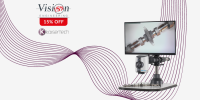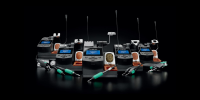


Selecting which soldering tip to use can be tricky. Especially when you see there are over 500 variations of cartridges to select from!
Within this article, we will explore the most common cartridge shapes. We will delve into why you would use each shape, and other considerations to think about.
Each cartridge shape has its own advantages, and disadvantages, so let’s explore.
General Process When Deciding Which Soldering Tip To Use
Let's outline the general process and decisions that you need to take before selecting your soldering tips. Consider the following three factors:
- Know the application you plan to undertake, precision, general, drag soldering, or other.
- Narrow down the shape and size of the soldering cartridge for your application.
- Taking into account the handpiece or specialist application you may be undertaking.
Common Tip Shapes
For most common work with electronics, the choice will be between 3 common tip shapes. These are chisel, conical and bevel.
Chisel
One of the most common tip variations in use. It helps to provide heat evenly to the components leads and pads.
Chisel tips are therefore flexible in their suitability. They are great for soldering wires, through-hole components, large surface-mounted devices and ever desoldering tasks.
The tapered edges of the tip allows for easy access between most components. You should ensure that the chisel tip you use for soldering is 60% the width of the pad.


Conical
Where you are undertaking precision soldering, conical tips provide the ideal shape. The tip has a pointed end, allowing a concentration of heat onto small areas, such as miniature SMDs.
These tasks can be difficult to conduct with other soldering tips.
You should use conical tips with caution.
One of the most common soldering mistakes involves the operator using too much force (often a novice solderers mistake).
Should you not take care when soldering, conical tips can become damaged easier than other tip variations.


Bevel
Often referred to as single flat tips, they have one flat edge and one round edge. Bevel tips cater to a vast range of applications.
The large surface of the tip holds more solder than that of other soldering tips. This makes it easier to drag solder across the SMDs to multiple pins.
You would use a bevel tip for work that requires pre-loading of the cartridge with solder.


Other Specialist Cartridge Shapes
There are many other shape variations within the JBC cartridge range. Over 500 different tip shapes and sizes, catering to all kinds of soldering applications.
JBC even offer bespoke designs should there not be a suitable tip within their catalogue.


Considerations For Selecting Which Soldering Tip To Use - Which Soldering Tip Should I Use?
Bigger Is Better
Firstly, and most importantly, the bigger the soldering tip used, the better the thermal transfer. You should always ensure that you select a tip that has the greatest contact area.
When using a tip with high thermal efficiency, you are actually 40% faster than if you were to select a tip with a slimmer geometry.
This is because the more mass the tip has, the greater the accumulated heat.
Ensuring that you stick to this rule of thumb, allows you to get better results in less time.
But, if a soldering tip is too large for the application, the tip can transfer too much heat. This can cause damage to either the component or the pad you are working on.
Versatility
If your soldering application requires different soldering techniques, and you do not want to invest in multiple cartridges, you must consider versatility.
When talking about versatility, there can only be one winner. The chisel!
These types of cartridges are the most universally relied on. they are perfectly suited for most general-purpose soldering tasks.
Chisels have a wide flat edge that aids in spreading heat uniformly across leads and pads.
Although as we stated above, JBC have a wide selection of tips, which may be the better route (rather than relying upon the chisel).
Volume Of Solder Used
Some applications need to be drag soldered.
This method involves a tip that is pre-loaded with solder and can quickly solder several pins in one swoop. Some tips have a concave within the centre of the cartridge that allows for this.
For these applications, there are specially designed cartridges that simplify this task.
Just search for "Drag" when looking for cartridges for this type of application.
Precision Required
Always consider the precise nature of the soldering task that you are conducting.
Generally speaking, when working on an application requiring precision soldering, conical tips provide the best results.
Their cone-like shape (almost pencil-like) enable them to reach into gaps where space is minimal). Conical tips also allow for the concentration of heat on a much smaller area.
Pad Cleaning & Rework
When it comes to reworking or cleaning tasks, blade tips provide you with the most optimal and time-saving cartridge shape. Bladed tips can be drastic time savers, with a broad and wider tip head than other cartridges.
Both knives and bladed soldering tips have an edge that allows the cartridge to reach slotted cavities where other shapes cannot.
This shape makes them effective at extracting solder from multiple pads at once. This is particularly effective when combined with a soldering braid and tacky flux.
Handpiece & Station Compatibility
Take careful consideration with regards to the handpiece and station that you purchase. Not all tip shapes are available for every cartridge.
When purchasing tips for an existing soldering station, check that the tips are compatible. Some soldering tips are specially designed for either precision work or heavy-duty soldering.
However, most cartridge shapes are available with the T245 handpieces when searching through the C245 tip range.
To Conclude...
We hope that this post has enabled you to get a better understanding of the different considerations needed for when deciding which soldering tip to use.
Should you have any questions specific to your application, or require assistance with purchasing soldering products, contact Kaisertech here.














